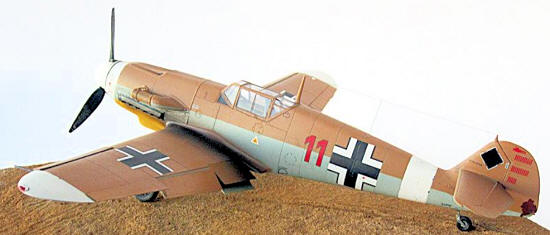 The Initial Image
The Initial Image
Slipping the Bonds
by George Paterson
Bf 109F-4-2.JG27-Friedrich Koerner-sa1
Introduction
The majority of images of JG27 aircraft in my archive are of Hans-Joachim Marseille's several planes. I have more than 60 of them. However, there were some other pilots in the Afrika Korps who deserve a mention in the history of the Desert war. One of them was Friedrich Koerner, who arrived in Africa in July 1941, and was shot down over the Allied lines exactly a year later, on 4. July 1942. He had scored 36 victories, but spent the remainder of the War in Canadian POW camps, and was released in 1947.
I have no in-flight art-works of Koerner's “Red 11”, but some good images of model builds, so I can base my in-flight image on one of these. Besides, I have the possibility of using one of the many model images of Marseille's aircraft – adapting it to represent Koerner's plane would be no big task.
 The Initial Image
The Initial Image
This is a photo of a model by Steffen Arndt using the Eduard kit. The review is accompanied by 14 images, all 800 pix wide, and of good and even definition. I chose to work on this image, the first of the 14.
Treatment of the Image
My first step was to modify the starboard wing so that more of it is revealed; this has the effect of reducing the apparent perspective.
With a starting image of this size it's worthwhile clarifying all the significant details, and I spent some time on this – it's particularly beneficial in the area of the forward fuselage, which has a lot of fine detail that gets rather lost by its remoteness from the camera.
 The
rear fuselage frames were clarified, and I ended up with slightly different
profiles than those on the model; the décor elements in that area were inserted
to be consistent with my profiles.
The
rear fuselage frames were clarified, and I ended up with slightly different
profiles than those on the model; the décor elements in that area were inserted
to be consistent with my profiles.
The rear fuselage and fin carry important décor items. The curious upper feature on the rudder shows the outline of a tank, followed by four small tally bars.
These 109F's had retractable tail-wheels, and nearly all the artworks that I have seen show the in-flight situation with them duly retracted. However, given the problems that the retracting mechanisms suffered, especially in desert conditions, it's not surprising that the mechanisms were often locked in the extended position. Fernandez-Sommerau says that eventually all retraction mechanisms were blocked off.
Conclusions
My favourite image of these desert 109's is Iain Wyllie's painting of Marseille and his wingman attacking some Allied P40's. His works are always very dynamic, and that one is no exception.